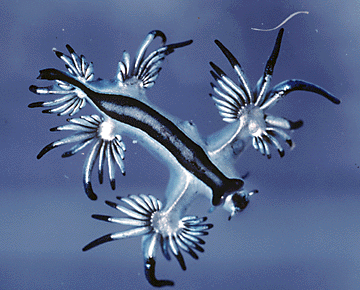Published in the Ocean Watch column, Honolulu Star-Advertiser © Susan Scott
September 5, 2011
The tradewinds have been blowing steadily this week, bringing to our shores the good, the bad and the ugly. Good first.
Joren of Laie emailed that he found near the shoreline some blue floating creatures that look like they have wings or legs. Joren and his siblings called the animal Pokemon since it looked so unreal.
 Photo by Susan Scott
Photo by Susan Scott
Sea slugs are snails without shells, also known as nudibranchs.
This nudi is a Glaucus atlanticus.
Pokemon is a good nickname for this fantastic offshore creature because its common name, blue sea slug, doesn’t do it justice. Sea slugs are snails without shells, also known as nudibranchs (NOO-dee-branks). This particular nudi is called Glaucus atlanticus.
At sea, this 1-inch-long snail swallows a bubble of air and floats belly-up and spread-eagle, drifting around the open ocean at the mercy of winds and currents.
When it runs into a Portuguese man-of-war, the Glaucus eats it. Somehow the snail is able to swallow the man-of-war’s tentacles without discharging the stinging cells, and recycles them for its own defense.
After periods of strong tradewinds, look for these snails on windward beaches. They roll into blue-and-white pea-sized balls. If it’s still alive and you drop it in a jar of sea water, the snail unfurls like a magic “Avatar” flower.
These little snails are hard to spot on our shorelines. Joren and his family were sharp-eyed and lucky.
Not so lucky was another reader, Louisa, who emailed to let me know that she and her family, while swimming off Kailua, were stung by what they thought were tiny jellyfish. No one saw the culprits, but when they came out of the water they had “blisters/ulcers all over the place where our swimsuits covered.” Louisa’s friend also got a painful rash in “sensitive regions” inside her swimsuit.
This description is classic for a seaweed known as stinging limu in Hawaii, fireweed in Australia. The species, called Lyngbya majuscula, sometimes contains potent toxins that cause skin lesions on contact.
Prolonged wind waves occasionally cause this hairlike seaweed to break off and drift free. Typically, fragments of the plant get trapped inside swimsuits, and that rubs the toxins into the skin. There’s no specific treatment for this sting except to take the suit off as soon as possible and wash the rash with soap and water. Wash the suit, too.
Hawaii’s lifeguards have photos and more information (which I wrote) about stinging limu on their website: www.aloha.com/~lifeguards/limu.html.
So that’s the good and the bad blowing in the wind. The ugly, of course, is the plastic junk blown from the open ocean onto our beaches. If each of us picks up a piece or two of marine debris while we’re at the beach, we can put the ugly in its place: a trash can.